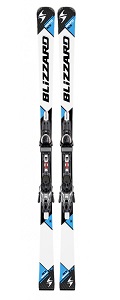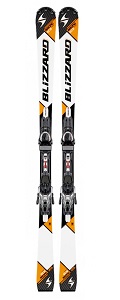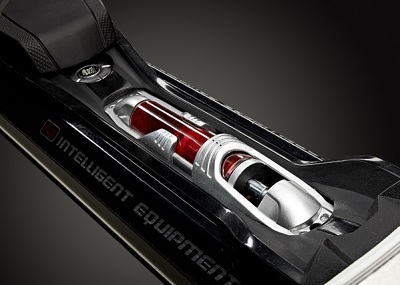
The Blizzard Race range of the 2014-2015 season is divided into three lines. And yet it is a quite straight forward to understand frame. The first model we encounter is a standalone model, the Blizzard WRC Racing WC Piston, which is a downgraded model spinned off from those on the top racing category, the FIS ones. Without the need to follow the official competition rules from the FIS, this ski is a very good option to get into how a serious competition style ski feels without having all the drawbacks. The other four models are splitted into two lines, short turns and long turns.
For those who prefer a racing touch in the long turns, you will find the Blizzard WRC Racing S + Power 14 TCX and the Blizzard RCS Racing S + Power 12 TCX very attractive. Despite the difficulty to remember those names, both are good and decent racing models for the average expert user.
On the other side of the story, the Blizzard Race models for enjoying the short turns are the Blizzard SRC Racing S + Power 14 TCX and the Blizzard SCS Racing S + Power 12 TCX.
The binding systems are also three. The one used in the Blizzard WRC Racing WC Piston is clearly the same used in competition models and yes, it´s made by the well known Marker brand. The other two models use a slightly different approach. Although the Power 14 TCX and the Power 12 TCX are very similar, since both do not use the IQ system proposed a few years ago by Blizzard and are connected to the ski using a more traditional method, they both are a step below the classic race plate named Marker WC Piston Control Interface for the superior model of the range, the Blizzard WRC Racing WC Piston.
There are five different technologies used in the Blizzard Race collection. To see which one is used on each model, you should have a look to each ski individual review.

The Duratec technology is everywhere
© Blizzard – Tecnica Group S.p.A.
Dura-Tec.
This technology consists on small but very important construction details that will allow our ski to have a longer life with us. From the top cover finishes to avoid those ugly scratches that usually appear when transporting the skis to the Alu tip protectors, through the thicker TPU foils as well as the tail rubber protectors or the simple and clever IQ Rail binding interface.
Sidewall Construction
Well… this is a very well known method through the whole industry as the one explained above, although marketers pack them all into fancy names that sound good enough for the buyer in a shop. Despite the fanciness, this time the names are based in true characteristics found in the Blizzard Race range. But yes, some of the properties are exagerated. I never thought of a sidewall construction that could benefit a ski with a “better energy transmission” or an “increased impact strength”. Even though in my mind “increased torsional stiffness” could fit, my heart tells me what really matters for that purpose is more in the inside of the ski. Or is it the other way around? Nevermind…
Full Camber.
Where everyone else is chosing to include the word rocker, even if it makes no sense, Blizzard is nailing it. This is their description:
“Traditional camber construction without any rocker lifting. Highest stability and edge-grip with maximum steering precision!”
Facts are facts and the first sentence is one of the real facts. The second sentence is just some pompous artillery… sort of.

© Blizzard – Tecnica Group S.p.A.
Race Tip Profile
This is what the brand states: “The new Race Tip Profile features a 30% shorter tip. This allows the ski to have longer effective edge length and the tip construction to be softer, resulting in more stability and less vibrations.”
Which is all true. And also makes the ski faster since it cuts the air more easily as it is well known in the World Cup, where usually DH skis have flatter tips compared to the rest of the skis used in competition. Some teams even tried so flattened tip designs that the FIS regulated the minimum height in order to avoid undesired accidents.
Suspension
Believe it or not, some Blizzard Race skis have a dampening system incorporated. The brand even got an award in the 2010 Munich´s ISPO for the R-Power Suspension IQ. Functional or not, it is tremendously ridiculous as a system and as a design. You can further read on this matter in the last´s year review.
The system consists in a fiberglass reinforced interface connecting the ski and the binding. It also has a dampening system “to minimize vibrations (10 times faster) and let users skiing with less fatigue”. Which is pretty close to say that we have no clue about what we are saying since no one knows what is it compared to (10 times faster than… what?). We have no clue since we deliberately copied Atomic´s Doubledeck system but had to “invent” something to hide it. And we also have no clue since that tiny little bottle (read red cylinder) cannot be refilled with our favourite alcoholic beverage (they could have solved the mess with that only feature).
And last but not least, the cover designs. They are beatiful wherever you look at them. The Blizzard Race hardcore model is more racing focused. The others also shine but in another fashion less strident and more pleasant to look at.

 Blizzard WRC Racing WC Piston
Blizzard WRC Racing WC Piston Blizzard WRC Racing S + Power 14 TCX
Blizzard WRC Racing S + Power 14 TCX Blizzard SRC Racing S + Power 14 TCX
Blizzard SRC Racing S + Power 14 TCX Blizzard RCS Racing S + Power 12 TCX
Blizzard RCS Racing S + Power 12 TCX Blizzard SCS Racing S + Power 12 TCX
Blizzard SCS Racing S + Power 12 TCX